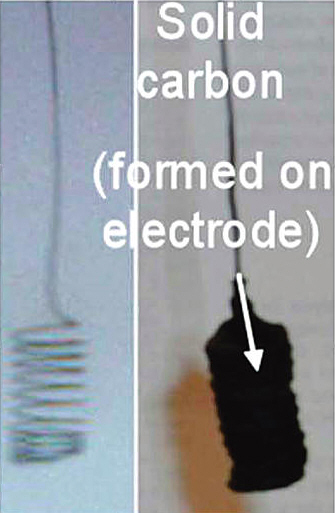Jul
28
Catching CO² to Make Some Useful Fuel
July 28, 2010 | 13 Comments
George Washington University’s Dr. Stuart Licht and colleagues have published the first experimental evidence of their new solar thermal electrochemical photovoltaic (STEP) process, which combines electrical and chemical pathways to convert CO2 to carbon or to carbon monoxide for subsequent use in synthesizing a range of industrially relevant products including hydrocarbon fuels.
According to the research team the STEP process is fundamentally capable of converting more solar energy than either photovoltaic or solar thermal processes working alone.
The STEP process uses a high temperature solar powered electrolysis cell to capture CO2 in a single step. Solar thermal energy decreases the energy required for the endothermic conversion of carbon dioxide and kinetically facilitates electrochemical reduction. Meanwhile visible light solar energy generates the electric charge to drive the electrolysis.
For the experiment, the team used a concentrator solar cell to generate 2.7 volts at a maximum power point, with solar to electrical energy efficiencies of 35% under 50 suns illumination, and 37% under 500 suns illumination. The 2.7 V is used to drive two molten electrolysis cells in series at 750 °C and three in series at 950 °C.
At 950 °C running at 0.9 V, the electrolysis cells generate carbon monoxide at 1.3-1.5 amps, and at 750 °C at 1.35 V generate solid carbon formation at similar amps.
The George Washington team also was thoughtful enough that the supporting information published along with the paper details the methodology and the materials used in the experiment.
Of great note and acclaim the research team addresses the questions of material resources, saying, “are sufficient to expand to process to substantially impact (decrease) atmospheric levels of carbon dioxide.” This perspective is rarely observed in research papers and the inclusion by the George Washington team deserves notation and gratitude. The information gives the research depth of understanding and better chances of improvement.
The key materials issues raised: “A related resource question is whether there is sufficient lithium carbonate, as an electrolyte of choice for the STEP carbon capture process, to decrease atmospheric levels of carbon dioxide. 700 km2 of CPV plant will generate 5×10^13 Amps of electrolysis current, and require ~2 million metric tonnes of lithium carbonate, as calculated from a 2 kg/l density of lithium carbonate, and assuming that improved, rather than flat, morphology electrodes will operate at 5 A/cm2 (1,000 km2) in a cell of 1 mm thick. Thicker, or lower current density, cells will require proportionally more lithium carbonate. Fifty, rather than ten, years to return the atmosphere to pre-industrial carbon dioxide levels will require proportionally less lithium carbonate. These values are viable within the current production of lithium carbonate. Lithium carbonate availability as a global resource has been under recent scrutiny to meet the growing lithium battery market. It has been estimated that the current global annual production of 0.13 million tonnes of LCE (lithium carbonate equivalents) will increase to 0.24 million tonnes by 2015.SI-1 Potassium carbonate is substantially more available, but as noted in the main portion of the paper can require higher carbon capture electrolysis potentials than lithium carbonate.”
Effectively, should the process be brought on line, 700 square kilometers (270 square miles) of this system would extract the “excess atmospheric CO2” within ten years. If those numbers were accurate an area less than 17 x 17 miles would mop up the “excess” carbon dioxide in the atmosphere. This is a stretch for reasoning, but the numbers work.
Also there is a platinum matter to consider if the design went to solid carbon capture, but the platinum would be recycled endlessly.
The team is also looking at STEP to generate synthetic jet fuel and synthetic diesel. That would get some of the carbon cycling.
The team is working at refinement and scaling of STEP for carbon capture.
Without needing a huge source of production energy by using solar the main problem – the energy needed to drive the heating and electrolysis could pretty much be resolved.
There are gaps in the explanation available in the supporting information. Of primary concern is the concentration level of the CO2 entering the process. It’s not clear how pure the CO2 would have to be. Just running air through is one thing, a concentration step to unspecified purity is quite another.
Yet the George Washington team is on to a system with great potential. The external energy production not needed is very significant; the potential for fuel production or sequestration, depending on one’s political views cannot be overlooked.
Solar powered CO2 to new fuel sources just got much closer.
Comments
13 Comments so far




this post is very useful, thx!
Useful for what?
I’m impressed, I have to say. Really rarely do I encounter a weblog that’s both educational and entertaining, and let me inform you, you have got the nail hit on the head. Your concept is excellent. I’m very completely satisfied that I stumbled across this in my search for one thing regarding this.
Hiya, I’m really glad I’ve found this information. Nowadays bloggers just publish about gossip and internet and this is really irritating. A good web site with exciting content, this is what I need. Thank you for keeping this web site, I’ll be visiting it. Do you do newsletters? Can’t find it.
Thanks for posting. Good to see that not everyone is using RSS feeds to build their blogs 😉
Good! Thank you! I always wanted to write in my site something like that. Can I take part of your post to my blog?
Great read. Thanks for the info!
I REALLY liked your post and blog! It took me a minute bit to find your site…but I bookmarked it. Would you mind if I posted a link back to your post?
I’ve just started off a blog, the knowledge you give on this site has aided me extremely. Thank you for all your time & work.
Hello, this is my first time i visit here. I found so many interesting in your blog especially on how to determine the topic. keep up the good work.
Thanks for sharing your thoughts about solar thermal electrochemical
photovoltaic. Regards
I’m impressed by how you make this simple and very understandable. Thanks you.
It’s very interesting, even though I am not study in that major, it’s very good to learn about this from your website. Thank you